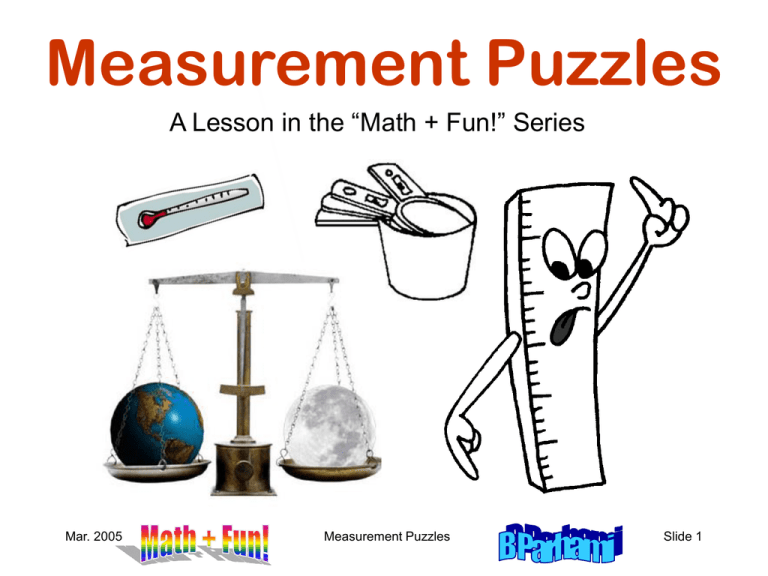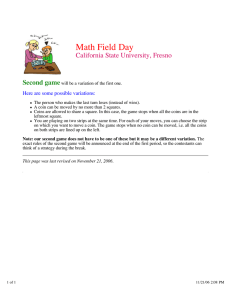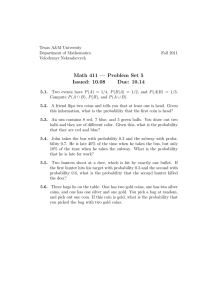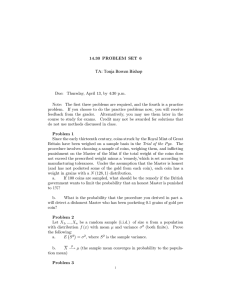Measurement Puzzles
advertisement

Measurement Puzzles A Lesson in the “Math + Fun!” Series Mar. 2005 Measurement Puzzles Slide 1 About This Presentation This presentation is part of the “Math + Fun!” series devised by Behrooz Parhami, Professor of Computer Engineering at University of California, Santa Barbara. It was first prepared for special lessons in mathematics at Goleta Family School during the 2003-04 and 2004-05 school years. The slides can be used freely in teaching and in other educational settings. Unauthorized uses are strictly prohibited. © Behrooz Parhami Mar. 2005 Edition Released First Mar. 2005 Revised Measurement Puzzles Revised Slide 2 Measurement for Cooking You have a 3-cup container and a 5-cup container only. The cups are not graduated. How do you measure one cup of sugar? 1=3+3–5 2=5–3 3 4 = 3 + 3 + 3 – 5 or 1 + 3 5 6=3+3 7 = 5 + 5 – 3 or 2 + 5 8=5+3 9=3+3+3 10 = 5 + 5 Challenge: Continue to 20 cups. Mar. 2005 5 3 10 Now add a 10-cup container and show how to measure 11 cups of sugar? 11 = 10 + (3 + 3 – 5) Measurement Puzzles Slide 3 Activity 1: Measuring Sugar You have a 1-cup, a 3-cup, and a 9-cup container. The cups are not graduated. How do you measure different amounts of sugar, from 1 to 30 cups, using the fewest number of steps? For example, use 3 once instead of 1 three times. 1 2=1+1 3 4=3+1 5=9–3–1 6=6–3 7=9–3+1 8=9–1 9 10 = 9 + 1 Mar. 2005 11 = 12 = 13 = 14 = 15 = 16 = 17 = 18 = 19 = 20 = 1 3 9 21 = 22 = 23 = 24 = 25 = Measurement Puzzles 26 = 27 = 28 = 29 = 30 = Slide 4 How to Get Half a Glass of Water? A cylindrical glass is filled to the brim. How do you get half a glass of its content without using any other item? Can’t do this if the glass has a conical, rounded, or irregular shape. Full glass Half full You have a container, with a tight lid or cork, filled to the brim with fruit juice. How do you divide the juice exactly in half without any measuring tools? Hint: Suppose the container is exactly half full. What happens if we close the lid or cork and turn it upside down? Mar. 2005 Measurement Puzzles Slide 5 Measurement at the Hardware Store A large container is known to hold 24 oz of nails. We have a balance, but no weights. Measure out 9 oz of nails for a customer. Divide all nails into two equal piles 24 12 oz 12 oz Divide one pile into two equal piles 12 oz 6 oz 6 oz . . . and again 12 oz Mar. 2005 Measurement Puzzles 6 oz 3 oz 3 oz Slide 6 Activity 2: Dividing the Snack Equally A bag contains carrot coins or m&m chocolates. You have a balance, but no weights. How would you give several kids an equal share of the snack? It’s okay to have some left over, as long as each kid gets the same amount. 4 kids: 5 kids: 8 kids: 15 kids: Mar. 2005 Measurement Puzzles Slide 7 Using only Four Weights A chemist has a balance and fixed reference weights of 1, 2, 4, and 8 grams. Show that she can weigh any amount of material from 1 to 15 grams by putting the fixed weights on one side and the material to be weighed on the other. 1, 2, 4, and 8 grams are obvious. 3=2+1 5=4+1 6=4+2 7=4+2+1 9=8+1 10 = 8 + 2 11 = 8 + 2 + 1 12 = 8 + 4 13 = 8 + 4 + 1 14 = 8 + 4 + 2 15 = 8 + 4 + 2 + 1 Using 1, 2, 5, 12 gram weights, Challenge: What are the best four we can weigh any amount of weights to use, if we can place material from 1 to 20 grams. them on both sides of the balance? Mar. 2005 Measurement Puzzles Slide 8 Activity 3: Weighing with Four Weights Show how to weight any amount from 1 to 40 grams. 1 2=3–1 3 4=3+1 5=9–3–1 6=6–3 7=9–3+1 8=9–1 9 10 = 9 + 1 11 = 12 = 13 = 14 = 15 = Mar. 2005 16 = 17 = 18 = 19 = 20 = 21 = 22 = 23 = 24 = 25 = 26 = 27 = 28 = 29 = 30 = 1 3 grams 9 grams 27 grams 31 = 32 = 33 = 34 = 35 = Measurement Puzzles 36 = 37 = 38 = 39 = 40 = Slide 9 Find the Lighter Counterfeit Coin We have 3 coins. Two are good coins; one is a counterfeit coin that weighs less. Identify the counterfeit with one weighing on a balance. Compare coins 1 & 2. If they weigh the same, coin 3 is counterfeit; otherwise the lighter of the two is counterfeit. We have 9 coins; eight good coins and a counterfeit coin that weighs less. Identify the counterfeit with 2 weighings. Mar. 2005 Measurement Puzzles Slide 10 Activity 4: Heavier Counterfeit Coin We have 3 coins. Two are good coins; one is a counterfeit coin that weighs more. Identify the counterfeit with one weighing on a balance. We have 9 coins; eight good coins and a counterfeit coin that weighs more. Identify the counterfeit with 2 weighings. Challenge: Find one heavier counterfeit coin among 27 with 3 weighings on a balance. Mar. 2005 Measurement Puzzles Slide 11 Odd Coin: Lighter or Heavier We have 12 coins. Eleven are good coins; one is a counterfeit that weighs less or more than a good coin. Identify the counterfeit coin and its relative weight with a minimum number of weighings on a balance. Hint: First do it for 3 coins, one of which is a counterfeit, using only two weighing, Compare 1&2 If equal, 3 is the counterfeit. Weigh 3 against 1 to see if it is lighter or heavier. If 1 lighter than 2, coin 3 must be good. Weigh 1 against 3. If equal, 2 is counterfeit & heavier. Otherwise, 1 is counterfeit & lighter. If 1 heavier than 2, do as in the previous case. Mar. 2005 Measurement Puzzles Slide 12 Odd Coin: Lighter or Heavier (cont.) We have 12 coins. Eleven are good coins; one is a counterfeit that weighs less or more than a good coin. Identify the counterfeit coin and its relative weight with a minimum number of weighings on a balance. Hint: First divide the coins into three groups of 4 coins: A, B, and C. Compare A&B If A = B, then C contains the counterfeit coin. Weigh 3 coins from C against 3 good coins. If equal, the lone remaining coin in C is counterfeit and one more weighing is enough to tell if it’s lighter or heavier than a good coin. Mar. 2005 Measurement Puzzles If the three C coins are lighter, then . . . If the three C coins are heavier, then . . . If A < B or A > B . . . Slide 13 Measurement with Scales We have 100 oranges in a heavy cardboard box. How can you find the weight of the oranges (without the box) using a bathroom scale? Bathroom scales are usually not accurate for small weights (say, less than 30 lbs) or very large weights (say, more than 200 lbs). How would you weigh a baby who is about 20-25 lbs using a bathroom scale? How would you weigh the 100 oranges accurately using the bathroom scale if you estimate the oranges to weigh 20-30 lbs and the cardboard box 3-5 lbs? Can you accurately weigh a person who is about 250-300 lbs using two bathroom scales? Mar. 2005 Measurement Puzzles Slide 14 Activity 5: Measurement with a Scale You have 5 packages of candy bars and a scale. Each candy bar is supposed to weigh 200 grams. One of the packages, however, contains candy bars that weigh 150 grams. Can you find the package with lighter candy bars using the scale only once? Extra challenge: You only know that one package contains lighter candy bars but you don’t know the weight of regular or lighter bars. How many times do you need to use the scale to find out the two weights and the package with lighter bars? Mar. 2005 Measurement Puzzles Slide 15 Measuring Length You are curious about the height of a light pole in or next to your house. Can you measure its height without climbing it? Light pole Hint: Think of shadows! If a 1-foot upright ruler casts a 6-inch shadow and the shadow of the light pole is 10 ft, the pole is 20 ft high. 1-foot ruler Standing next to a stream that you can’t cross, you and a friend make a bet. She says that the stream is 15 ft wide; you say that it is 20 ft wide. You have a 30-ft piece of string and a 1-ft ruler. How can you decide who is right? Mar. 2005 Measurement Puzzles Slide 16 Measuring Volume How can we measure the volume of an irregular object such as a chess piece? 1. Put a container filled with water inside a larger container. 2. Slowly insert the item into the inner container. 3. Measure the volume of the water that spills out by pouring it into measuring cups. Mar. 2005 Measurement Puzzles Slide 17 Next Lesson Thursday, April 14, 2005 1. 2. 3. 4. 5. Think of a 2-digit number (10-99). Multiply your number by 5. Add 500 to the result of step 2. Add the number of your siblings. Double the result of step 4. Mar. 2005 You got a 4-digit number that starts with 1, has your original 2-digit number in the middle, and double the number of your siblings at the end. Measurement Puzzles Slide 18






